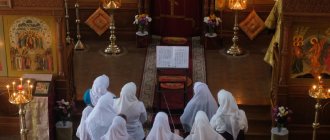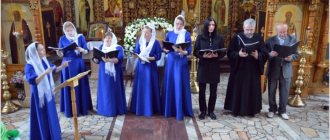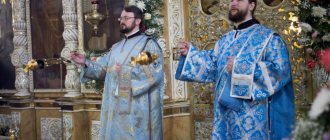Content
- 1. History
- 2 Music in Orthodox worship 2.1 Chants
- 2.2 Russian spiritual concert
- 3.1 Motet
- 4.1 Protestant Mass
Types of religious vocals
Religious singing is divided into 6 main types:
- Antiphonal. It consists of two choirs, which are located on the sides of the iconostasis. The choirs sing in turns, first the one on the right sings a whole chant, and then the one on the left sings another. It happens that when a chant is long, it is divided into several parts, and then it is performed in turn. Poems are also performed. The name "antiphon" comes from "opposition", a dialogue between 2 groups. Today this almost never happens, only 1 choir sings, but until 1917 in Moscow and other cities they performed it like this;
- Epiphonic. Adding to the verse of the psalm one more verse before the psalm. That is, epiphonic means the refrain is preceding;
- Ipophone. Similar to epiphonic, only the verse is inserted after;
- Responsor (from Latin - responsum - answer). There are different methods of execution. 1) The performers speak by singing 1 and the same text for each request of the clergyman. 2) The person reads all the verses of the psalm, and the singers respond by saying the first verse spoken. This is how, for example, prokeimnas are performed;
- Canonarch. He was accepted in Russian monasteries. Canonarch is somewhat similar to responsor. You can call it “singing to a prompter,” since the function of the canonarch is similar to the function of the prompter. He speaks the text, psalmodizing in one tone. Others repeat his text, already singing it;
- Gymnastic. Sung completely without interruption. This is how they perform, for example, “Quiet Light.”
Story
The most ancient genre of Christian liturgical music is the Psalm, borrowed by the first Christians from the Jews. The psalms of David in Old Testament times were sung not only as an obligatory part of services in the only temple in Jerusalem on earth, but also in numerous synagogues in different cities, and even in home prayers. Jesus Christ himself often sang psalms with his disciples:
«And having sung, they went to the Mount of Olives.
»
— Mf. 26:30
«And having sung, they went to the Mount of Olives.
»
- Mk. 14:26
Translated from Hebrew into Greek and Latin, the psalms remained at the heart of Christian worship. They were performed in one voice - in unison, as was customary among the Jews, but without instrumental accompaniment.
However, the Apostle Paul already authoritatively testifies to the active participation of Christians in the composition of various New Testament prayers and chants:
«When you come together, and each of you has a psalm, there is a teaching, there is a tongue, there is a revelation, there is an interpretation - let all this be for edification. If someone speaks an [unfamiliar] language, [speak] two, or many three, and then separately, and explain one.
»
— 1 Cor. 14:26-27
According to the Byzantine historian of the 5th century, Socrates Scholasticus, already in the 1st century, Bishop Ignatius the God-Bearer of Antioch introduced special antiphonal singing into Christian worship[1]. Following this, a special (psalmodic) manner of performing psalms was developed - slow recitation, which does not allow the expression of emotions [2]. Together with the texts of the psalms, this manner of execution was inherited by the Liturgy.
Even in ancient times, the Pythagorean system was established and consolidated in the music of the ancient Greeks, thanks to which natural (Church tones) diatonic modes (modal scales, harmonies) appeared, inherent in traditional folk and religious music. Some of them formed the basis of special church tunes - voices:
- Dorian
, - Phrygian
, - Lydian
, - Mixolydian
.
Later, 4 more derivatives appeared (indirect, by-products - lat. toni plagales):
- Hypodorian
, starting with the note "", and having a dominant on the 6th degree, - Hypophrygian
, starting with "", with a dominant on the 7th degree, - Hypolydian
, - with “”, with a dominant on the 6th degree, - Ipomyxolydian
, - with “”, with a dominant on the 7th degree.
This is how eight voices turned out - Osmoglasia. These voices were first proposed by Bishop Ambrose of Milan, but were introduced into general church practice by Gregory the Dvoeslov, Pope of Rome[3][4]. Each chant is assigned one of these eight voices
, whose melody best corresponds to the number of syllables in each individual semantic phrase and the consistent rhythm of stressed and unstressed syllables of the ancient Greek original liturgical text.
In exceptional cases, special melodies of various similars
and
samoglasnys
.
Each voice has several options for solemnity and complexity, depending on the degree of importance of the moment of worship:
- stichera
(for stichera), - sedal
(for sedals), - troparion
(for troparia), - kondakarny
(for kontakia), - irmosnoy
(for irmos), - exapostilary
(for exapostilarius), - and others
.
The Venerable Roman the Sweet Singer enriched church music with kontakia in the 6th century. In the 7th century, thanks to the Venerable Andrew, Archbishop of Crete, the canon (chant) firmly entered church music as a special musical genre, and in the 8th century, the Venerable John of Damascus finally consolidated the musical system of osmoglasia
(Octoechos).
When translating church hymns from Greek into Latin, Syriac, Georgian, Armenian, Arabic, Church Slavonic or any other language, the poetic metric of the original text is completely lost. In addition, many peoples of the East have musical intervals smaller than semitones ( quarter tone, trete tone, hexa tone, microtone
etc.), which significantly changes the entire melody of church music.
Pope Gregory I
In Western Europe in the 8th-9th centuries, a style of liturgical singing developed, called “Gregorian” in honor of Pope Gregory I, since tradition attributed to him the authorship of most of the chants of the Roman liturgy. Single-voice Gregorian chant (or Gregorian chant) provided for different, but strictly defined degrees of chanting - from recitation to melodically developed melodic structures. At the same time, in general, the manner of performance remained strict, restrained, with smooth transitions, gradual ascents and descents. The chant strictly obeyed the text, which determined its rhythm. At the same time, only male voices were present in the church choir. In Gregorian chant, two types of performance are distinguished: antiphonal - alternating two choirs and responsorial - the singing of the soloist alternates with small replicas of the choir[5].
The basis of early Christian worship was biblical texts; Gradually, new parts were added to them, specially composed, but the names of the authors of these texts are mostly unknown to us: either history has not preserved them, or the authorship is disputed (such as the famous hymn “ Quiet Light...
"). The musical arrangement, which was developed through the process of selection, processing and unification, was initially just as anonymous. Gregorian chant developed and became more complex along with the text of the liturgy, and already in the 9th century, early forms of church polyphony—the 2-voice organum—were based on it. In its further development, polyphony replaced the Gregorian chant[5].
Liturgical art - what is it?
To understand the essence of church singing, it is necessary to perceive it holistically. Liturgical art combines the incompatible, and strict rules developed over centuries do not at all limit freedom of expression. Famous Orthodox works (we will find out what the church hymn is called a little later) by such famous authors as Cosmas Maiumsky, Andrei Kritsky, Roman Sladkopevets and other church figures amaze with their freedom and courage. Mosaics, frescoes, icons of Andrei Rublev, Dionysius and other icon painters help to elevate the mind and heart to the primary source of beauty and harmony.
A temple is a place where worship takes place, where people partake of the Bloodless Sacrifice, so the chant must correspond to everything that is happening around. Only then can it rightfully be called church.
The one, holy, catholic and apostolic Church is a collection of brothers and sisters in faith. Consequently, church Orthodox chants are applied cathedral art. In other words, collective art aimed at serving the goals and objectives of the Church.
Music in Orthodox worship
Main article: Orthodox music
The most important genres of Orthodox liturgical music, in addition to the psalms and antiphons common to all Christian denominations, are the troparion, stichera, canon (chant), litany, kontakion, magnification, Eucharistic chants “Like the Cherubim”
,
“The Grace of the World”
, etc.
In a fully formed Orthodox service, singing accompanies all its parts - liturgy (mass), vespers and matins (on the eve of major holidays - all-night vigil), etc., rites of baptism, wedding, burial, as well as services - prayers, memorial services, etc. Even in Byzantium, different styles of singing—chants[6]—developed for different genres and different parts of worship.
Orthodox worship, unlike Catholic worship, is exclusively vocal. Instrumental accompaniment is not permitted. The Orthodox Church did not accept the "organ buzz"; here the only instrument was still the human voice[7].
After the occupation of Southwestern Rus' by Lithuania, and then by Catholic Poland and the Hungarians, Russian Orthodox singing adopted the technique and style of Western European partes music. In the Russian state, and especially in the Russian Empire, already from the 17th century, a fashion for everything European, including church singing,
. Therefore, the common melodies (most often Kyiv melodies in four voices) sounding in the churches of the modern Russian Orthodox Church have nothing in common with the Old Russian Znamenny and, especially, with the Byzantine chants.
Chants
The simplest manner of performance was psalmody - chanting (liturgical recitative); The psalmody was intended for reading the Gospel, the Apostle and the Prophecies[6].
The most difficult thing was kondakar singing
- a wide chant, decorated with melodic inserts. In Byzantium, it was used for the most solemn chants of the service - kontakia (hymns of significant length, in which stanzas performed by the soloist were interspersed with choral refrains) and cynics. This virtuoso singing was also cultivated in Kievan Rus - for the performance of cinematic songs, verses from psalms and choruses to them. But the complexity of kondakar singing eventually became the reason for its disappearance - already by the 14th century[6].
Kondakar singing is sometimes considered as a type of Znamenny chant, which dominated Russian Orthodox worship from the 11th to the 17th centuries[8]. Depending on the nature of the chant and its place in the service, three types of chant were used: small znamenny, characterized by simple melody, built on alternating musical lines, from 2-4 to 9 or more. The central place in the service was occupied by the Znamenny, or pillar, chant itself, which consisted of chants; in the chant, various chants were combined, forming a single line of melodic development. The choice of chants and their sequence determined the individual form of the chant. The Great Znamenny chant was distinguished by its richness and development of melody, and was usually used in the performance of festive stichera[6].
All these chants were monophonic; in the middle of the 17th century, new monophonic chants were added to them - Kiev [9], Bulgarian and Greek. However, already in the 16th century, early forms of polyphonic singing arose in Rus', and in the 17th century, the so-called partes polyphony spread, which very soon replaced znamenny singing[6].
Complex partes singing, in which the number of voices usually ranged from 3 to 12, but could reach 48 (in particular, in partes concerts of the 18th century), contributed to the further development of not only church musical culture, but also secular one. Polyphonic adaptations of the znamenny chant appeared, and then a new genre - the partes concert a cappella[6].
Russian spiritual concert
The spiritual concert, which was a “competition” of two or more choirs opposed to each other, came from the West, directly from Catholic Poland, in the 30s of the 17th century, first to Little Russia, and after reunification with Russia, and already in the traditions of Russian partes singing developed through the efforts of a number of composers. This is, first of all, Vasily Titov, the author of numerous concerts and services; Concerts by Fyodor Redrikov, Nikolai Bavykin, and Nikolai Kalashnikov have also been preserved[6].
Unlike Western European ones, the Russian spiritual concert, in accordance with the traditions of worship, did not involve instrumental accompaniment. Classic examples of works of this genre in the second half of the 18th century were created by Maxim Berezovsky and Dmitry Bortnyansky: this is a large-scale choral work with contrasting methods of presentation, with a comparison of 3 or 4 different parts[6].
Christian tradition
Christian sacred music is incredibly diverse: from canonical to very free, performed to popular tunes. Thanks to reformist trends and collaboration with prominent secular composers, she has come a long way from monophonic singing to complex polyphonic concerts, became closer to people and had an invaluable influence on world culture.
Genres of foreign sacred music:
- mass;
- requiem;
- psalm;
- sequence;
- passionata;
- chorale
As is known, the Byzantine canons did not allow instrumental accompaniment, limiting themselves exclusively to vocal performance. This served to develop a slightly different tradition, which differed significantly from the Western one.
List of Orthodox genres:
- grandeur;
- kontakion;
- all-night vigil;
- surplice;
- liturgy;
- troparion
In short, Orthodox and Catholic music is characterized by deep solemnity and sadness. It should remind believers of the suffering of Jesus Christ and teach a lesson from the Holy Scriptures. Listening to church chants and the majestic sounds of the organ, a person is simply obliged to be imbued with the eternal and understand all the secondary importance of earthly existence.
In Protestantism, everything looks different. For example, many evangelical churches play joyful, major-key melodies that call parishioners to joy.
Music in Catholic worship
Starting from the 10th century, tropes began to penetrate into monodic chorales - insertions of hymnographic (that is, freely composed) texts, and sequences. By the 12th century, the organum had developed into three- and four-voice treble, and then into more complex forms; on their basis, in turn, in the 13th-14th centuries, large forms of choral church music developed - the mass (which grew gradually) and the motet. The Council of Trent in the mid-16th century banned tropes and all sequences except four [6]: Victimae paschali (Easter Sacrifice), Veni Sancte Spiritus (Come, Holy Spirit), Lauda Sion (Praise, Zion) and Dies irae (Day of Wrath) Tommaso da Celano, which became the main part of the canonical funeral mass (requiem). Later, the Stabat Mater of the Franciscan Jacopone da Todi was also canonized.
Starting from the 11th century, the organ slowly (at first only the churches of the largest cities could afford this expensive innovation) in Western and Central Europe, but steadily spread; with him came instrumental accompaniment to the church, strictly regulated, like everything in the Roman Catholic worship of that time: the sound of the organ added solemnity to certain parts of the service[7]. For centuries, the organ remained the only permitted instrument in the Catholic Church; strings appeared much later, and already in the 17th century, during the Baroque era, a purely instrumental work for strings came into church use - sonata da chiesa (church sonata), a type of trio sonata[ 6]. At the turn of the 16th-17th centuries, the largest cathedrals already had their own instrumental chapels (which could perform outside the church), which was also reflected in the evolution of traditional genres of church music[6].
Motet
Main article: Motet
The motet, born in France in the 13th century, is not a purely church genre: from the very beginning, motets were also composed on secular texts, using secular melodies as cantus firmus. But the complexity of this genre of choral music, in which one melody was polyphonically combined with one, two, or even three others and at the same time each voice sang its own text, made it difficult to perceive the text. As a result, outside the church, the motet became a kind of “learned” music on which composers honed and demonstrated their skills. In the church, the motet gradually became simpler - in the 15th-16th centuries, Josquin Despres, Orlando Lasso, Giovanni Gabrieli and Palestrina already wrote single-text motets, strictly vocal, without instrumental accompaniment, choral works officially approved by the Catholic Church[10].
Mass
Main articles: Mass (musical work)
and
Requiem by
Giovanni Pierluigi da Palestrina
The earliest author's masses known to us date back to the middle of the 14th century and belong to the Frenchman Guillaume de Machaut - polyphonic choral works (more precisely, arrangements of the ordinary) “Mass of Notre-Dame” and “Mass of Tournais”. The Mi-Mi Mass of Johannes Ockeghem is considered an outstanding example of the Dutch school of the 15th century; The earliest of the requiems that have come down to us also belongs to him[11].
Polyphonic arrangements of Gregorian chants of the mass were created at the turn of the 15th-16th centuries in Germany, at the chapel of Emperor Maximilian I, primarily by Henrik Isaac and his student Ludwig Senfl[6].
During the Renaissance, the performance of the Catholic Mass gradually evolved from the choir exclusively a cappella to the alternation of choir and organ in the alternatum manner (when each verse is first sung by the choir, then repeated by the organ) and, finally, already in the 17th century, and somewhere earlier - to choir accompanied by string instruments. Sonatas for various compositions of instruments in certain sections of the service could replace choral parts. Thus, the famous Sonata sopra Sancta Maria by Claudio Monteverdi was intended to be performed during the evening service[6].
However, complicated polyphonic singing and solo organ playing during worship, which became widespread by the middle of the 16th century, caused a reaction from the church leadership: the same Council of Trent decided to clear the Gregorian choral repertoire of later layers and demanded more attention from composers to the word. Experts consider the work of Palestrina, who wrote strict a cappella choral works with transparent polyphony, to be an example of “post-Tridentine” Catholic culture[6].
Spiritual concert
At the same time, in Venice in the middle of the 16th century, a new direction in church music was born - concert music, which was a “competition” of two or more choirs opposed to each other. The origin of this trend is associated with the name of Adrian Villart, who wrote polyphonic arrangements of psalms and biblical songs (especially the Magnificat)[6][12]. Later, polychoral motets by C. de Pope, C. Merulo, Andrea and Giovanni Gabrieli appeared, with rich instrumental accompaniment. From the end of the 16th century until the middle of the 18th century, there was a struggle in the Catholic Church between the traditional “Roman” school (in particular, Alessandro Scarlatti and partly F. Durante continued to work in this style) - and the new direction, stile moderno (ars nova, seconda prattica ), striving to strengthen the instrumental principle, on the one hand, and, under the influence of the emerging art of opera (one of the early representatives of this direction was Claudio Monteverdi), to complicate the vocals, on the other. Representatives of this trend included purely instrumental, often of secular origin, compositions for organ or string ensembles into the Mass, introduced solo aria-recitative singing, etc. - that is, they moved further and further from church music itself. And in this struggle, the traditional direction ultimately had to give in[6].
Responsor view
If you translate the term “responsum” into Russian, you get the word “answer”. The holy text here can also be spoken in two ways:
- The text of the petition is accompanied by a response or appeal from the priest.
- The verses are pronounced by the singer in order, and the choir responds by duplicating the first lines spoken.
The repetition can be duplicated by two choirs alternately. In the finale, the beginning of the first verse is psalmodized, and the choir responds to the main performer by pronouncing the second half. Prokimny are sung in exactly this way. To summarize: this type of choral creativity is a combination of hypophonic and antiphonal singing interspersed with psalmody reading.
Music in Protestant worship
The significantly greater openness of the Protestant Church to the world compared to the Catholic Church and the less strict attitude towards the ritual side of church life were also reflected in its musical culture; the interpenetration and mutual influence of church and secular culture, which has existed in one way or another at all times, is much more pronounced in Protestantism; finally, the church itself, abandoning the fundamental opposition of the spiritual to the worldly, not only held divine services, but also organized concerts for parishioners, which became a practice of the Catholic Church only a few centuries later. The “godliness” of the music performed in these concerts did not oblige it to be purely church [13].
Johann Sebastian Bach - Cantor of St. Thomas Church
Along with the Latin language, the Protestant Church abandoned many of the rituals of the Catholic Church and, accordingly, the associated genres of church music. On the other hand, both Martin Luther himself and his followers composed their songs for church use - in their native language[6].
Lutherans in Germany, and later Puritans in England, expelled the organ from their use as an attribute of the papist church; in Germany, moreover, the Thirty Years' War led to the impoverishment of the country and the decline of musical culture[7]; the mass was performed exclusively a cappella. But in the second half of the 17th century, the organ returned to the Lutheran Church, and from that time on, it paid much more attention - compared to the Catholic Church - to music itself, giving more rights to accompanying instruments, primarily the organ[7]. The responsibility for the organ accompaniment of a mass or chorale lay with the organist or cantor, who could either write the music themselves or use the works of others, including the court composer Michael Praetorius.
Protestant Mass
Of the six parts of the Catholic Ordinary, the Protestant Church retained only the first two parts - Kyrie eleison ("Lord, have mercy") and Gloria ("Glory"). At the same time, the function of the organ was not reduced to simple accompaniment of the choir: organ preludes preceded and completed the service; preludes, as well as fantasies, ricercars, toccatas could be performed during the service - something that the Roman Catholic Church struggled with developed freely in the Protestant Church[7].
Protestant chorale
Main article: Protestant chorale
Having shortened the Catholic Mass, Martin Luther introduced the so-called “German Mass” into the divine service; in his work “Deutsche Messe” (1526), he even recommended that small towns limit themselves to the “German mass”, which consisted exclusively of German chants, later called the Protestant chorale[6].
In this part of the service, according to Luther's plan, the community should sing songs and hymns of a religious nature in chorus; Accordingly, the musical arrangement of the texts, which in some cases were original compositions, in others - texts from Catholic services translated into German, should be simple, accessible to non-professional performers - which prompted the Protestant Church to return to the traditions of monophonic Gregorian chant[6].
The Protestant chant combined several traditions: in addition to the Gregorian chant, the traditions of the old forms of German spiritual song, Leise (grew from the exclamations of the Kyrie eleison) and Rufe (where short stanzas of the chorus alternate with long stanzas of the refrain), as well as songs of the 15th century in the style of the Minnesingers and early Mastersingers. As in the mass, the organ played an important role here: a prelude on chorale themes preceded this part of the service, and during the course of it various pieces could be performed, often improvisational and, in contrast to the chorale itself, polyphonic[6].
William Bird
When it comes to Protestant worship, it is not always easy to say what is actually church music here, and what is music admitted into the church thanks to its openness: the genres of toccata, ricercar, prelude and fantasy were not born in the church, and they were not only performed during services, but also in concerts; and even for the chants of the “German Mass” Luther often chose the melodies of secular songs popular at that time[6]. One way or another, music for the use of the Lutheran Church was written by the greatest German composers of the 17th-18th centuries, from Michael Pretorius and Heinrich Schütz to J. S. Bach.
In the Anglican Church, after its separation from Rome in 1534, the mass was performed in Latin for a long time, and accordingly, traditional genres continued to develop - mass and motet; Many works in these genres were created by William Bird. However, already in the 30s of the 16th century, T. Sternhold and J. Hopkins translated the psalms into English and, together with other composers, composed new melodies for them. At the turn of the 16th-17th centuries, polyphonic arrangements of psalms were also created. In England, an original genre of church music also appeared - anthem, a chant in which solo parts alternate with choral parts, performed accompanied by an organ or string instruments. Thomas Morley, William Bird, O. Gibbons, Henry Purcell, and G. F. Handel wrote works in this genre[6].
During the Age of Enlightenment, many traditions of the Protestant Church were forgotten; After the death of J. S. Bach, not many significant works were created in the cantata genre; oratorios on religious subjects from the end of the 18th century were written for the concert hall, and not for the church. However, at the end of the 19th century, a number of societies were formed in Germany to study and promote old Protestant music (the most famous representative of this movement is Albert Schweitzer), and in the 20th century many German composers already wrote Protestant music: K. Thomas, I. N. David, H. Distler, E. Pepping, I. Driesler, H. W. Zimmerman...[6]
Evangelical Christian music
Baptist pastor Benjamin Keach was at the origins of evangelical Christian music. Around 1673, he forced the congregation of his church in Southwark to sing a hymn at the end of communion (referring to Mark 14:26).[14] The new practice caused controversy - at the time, singing texts not taken entirely from the Bible was considered a "manifestation of papism" and was seen as a form of memorized "fixed prayer", so some parishioners left the church before the singing began. Despite threats of excommunication, Keach continued his musical ministry - in 1679 he introduced the singing of one hymn “on days of public thanksgiving,” and in 1697 he released a collection of 37 hymns composed for singing during communion [ source not specified 3022 days
].
A new stage in the development of gospel music is associated with the name of Charles Wesley, John Wesley's brother. Charles wrote 6.5 thousand hymns, embodying his Christian experience - repentance, forgiveness, sanctification. G. F. Handel wrote the melody for three of Charles's texts. Charles's hymns were sung in Methodist congregations by the entire congregation, sometimes men and women sang in turns [ source not specified 3022 days
].
The traditions of the Wesley brothers were continued by the “sweet singer of Methodism” - Ira David Sankey (1840-1908), who accompanied the ministries of the American evangelist Dwight Moody. Sankey successfully used popular musical styles as a means of evangelism. An advertisement for the ministry of these two preachers read: “Moody will preach
Gospel, Sankey will
sing
the Gospel."[15] At the same time, Salvation Army General William Booth introduced imitations and borrowings from “secular” music. He answered his critics: “Worldly music, you say? Belongs to the devil? Well, even if it were so, I would have taken it away from him...”[16]
At the beginning of the 20th century, the music ministry of evangelical churches in America was significantly influenced by gospel music. At the same time, there was a tendency towards creating more professional music. To participate in church services, permanent (often family) musical groups were formed. With the growth of religious broadcasting on radio and television, such groups began to sound outside the church. In the second half of the 20th century, this led to the creation of modern Christian music as a separate genre of pop music[17].
Worship at Hillsong Church
In Russia, the creation of a music and singing ministry of Evangelical Christians is associated with the name of I. S. Prokhanov. Prokhanov wrote 624 songs and translated another 413 from English, German, Latvian, Finnish, Estonian[18]. In 1902 he published a collection of Gusli. About the concept of gospel music in Russia, Prokhanov wrote:
| Orthodox church music was beautiful, but sad... The music of the Evangelical Christian movement could not be sad... I decided to do everything so that Gospel music would be able to express the highest joy that exists on Earth, a joy whose source is heaven[19]. |
In the 1970s, a new style of “praise and worship” developed within the Jesus Movement (made up of Christianized hippies) .
). The style was initially used in the churches of the charismatic movement, but subsequently penetrated into other Protestant denominations.
Choral singing
It is not surprising that the choir singing is mostly choral: all voices are evenly distributed, each part is sung dispassionately, neither loudly nor quietly, surprisingly delicately and softly. Either it is performed in one voice (unison) with an ison (when several voices hold one bass note) - this is either a Byzantine chant or a znamenny chant.
If the music being played has all of the above advantages, then it can rightfully be called liturgical art.
Notes
- Life of the Hieromartyr Ignatius the God-Bearer.
- Uspensky N. D.
Psalms // Musical Encyclopedia (edited by Yu. V. Keldysh). - M.: Soviet Encyclopedia, 1978. - T. 4. - in the west, the count of voices is different: each main voice is followed by its secondary one, and subsequently a 9th is added to them, representing a mixture of the 2nd and 8th - Lat. tonus peregrinus sive irregularis
- Professor Mikhail Nikolaevich Skaballanovich “Explanatory Typikon”: VI-VIII centuries: Osmoglasie.
- ↑ 12
Gregorian chant // Musical encyclopedia (edited by Yu. V. Keldysh). - M.: Soviet Encyclopedia, 1974. - T. 2. - ↑ 1 2 3 4 5 6 7 8 9 10 11 12 13 14 15 16 17 18 19 20 21 22 23 Baranova T. B. , Vladyshevskaya T. F.
Church music // Musical encyclopedia (edited by Yu. V. Keldysh ). - M.: Soviet Encyclopedia, 1982. - T. 6. - ↑ 1 2 3 4 5 Bakeeva N.
Organ. - M.: “Music”, 1977. - About the project | Znamenny singing (undefined)
. znamennoe.ru. Date accessed: October 26, 2021. - Solovyov N. F.
Kiev chant // Encyclopedic Dictionary of Brockhaus and Efron: in 86 volumes (82 volumes and 4 additional). - St. Petersburg, 1890-1907. - Motet // Musical encyclopedia (edited by Yu. V. Keldysh). - M.: Soviet Encyclopedia, 1976. - T. 3.
- Levik B.V.
Requiem // Musical Encyclopedia (edited by Yu. V. Keldysh). - M.: Soviet Encyclopedia, 1978. - T. 4. - Raaben L. N.
Concert (work) // Musical Encyclopedia (edited by Yu. V. Keldysh). - M.: Soviet Encyclopedia, 1974. - T. 2. - A. Schweitzer.
Chapter 8. Bach in Leipzig // Johann Sebastian Bach. - M., 1965. - Crisis of Traditional Worship (Evangelical Church) No. 17
- Popov V.
Evangelist Dwight Moody
(unspecified)
(inaccessible link). "Faith and Life", No. 3 (1988). Access date: April 11, 2013. Archived November 4, 2011. - Andrew Wilson-Dixon.
History of Christian Music. - St. Petersburg: Mirt, 2001. - P. 210. - ISBN 5-88869-097-X. - J. Gordon Melton.
Encyclopedia of Protestantism. - New York: Facts On File, Inc., 2005. - P. 283. - ISBN 0-8160-5456-8. - Zharnasek I.
Optimism of faith: the life and work of Ivan Stepanovich Prokhanov
(unspecified)
(inaccessible link).
Interchurch dialogue
. Belarus is Christian. Access date: April 11, 2013. Archived April 22, 2007. - Prokhanov I. S. In the Cauldron of Russia, 1869-1933. Presentation of the main facts of the Evangelical Christian movement in Russia
Varieties of church hymns
Two types of chants can be distinguished:
- Liturgical (Divine service). It can be divided into statutory and non-statutory
- Paraliturgical. Not liturgical, non-church.
Types of liturgical (liturgical) singing
Liturgical chant can be divided into 2 types:
- Statutory. Such chants are established by the Typikon. From Greek, “liturgy” is translated as “service”, which is why the songs of other services are called liturgical;
- Extra-temple. They are sung during services, but they are not approved by the Typikon. They are divided into 9 types (akathists, magnifications, canons, at prayer services, spiritual cants, funeral cants, wedding cants, carols, shchedrovki). This type also includes verses sung during the communion of believers at the Liturgy;
Types of paraliturgical chants
Paraliturgical chant is divided into 7 types:
- Repentant. They are usually sung during Lent. Such melodies are slow and sad. You can include, for example, “Behold the Bridegroom will come at midnight”;
- Lenten. They are similar to penitential ones, sung during Lent. Their tempo is slow, and their motive is serious and sad;
- Wedding. They are sung when a wedding takes place. The motive is funny. These include, for example, “Glory to Thee, God, glory to Thee”;
- Funeral. They are sung during remembrance. They sound mournful, tragic, the tempo is leisurely. These include, for example, “Eternal Memory”;
- Easter. They are sung during the Easter Week services. They sound festive. As an example, “Resurrection Day”;
- Carols. The name comes from the word caroling. They are sung during Christmas, after Christmastide. They are short poems for which they give a reward in the form of sweets;
- Shchedrovki. They are similar to carols, sung on the occasion of the old New Year. You can also get a sweet reward for them;









